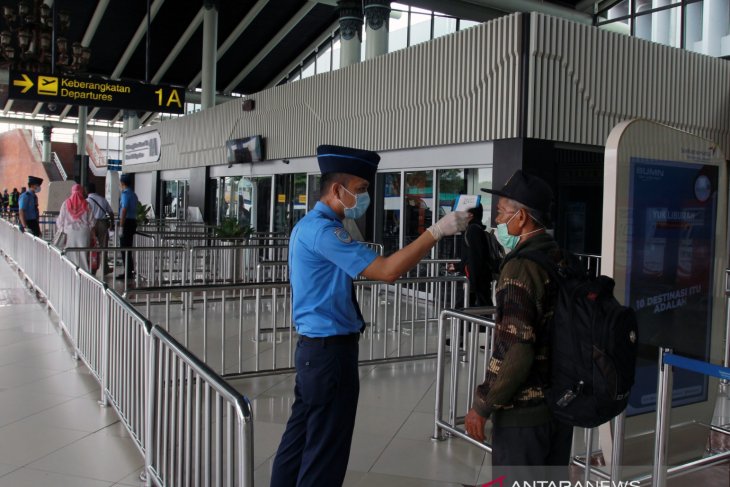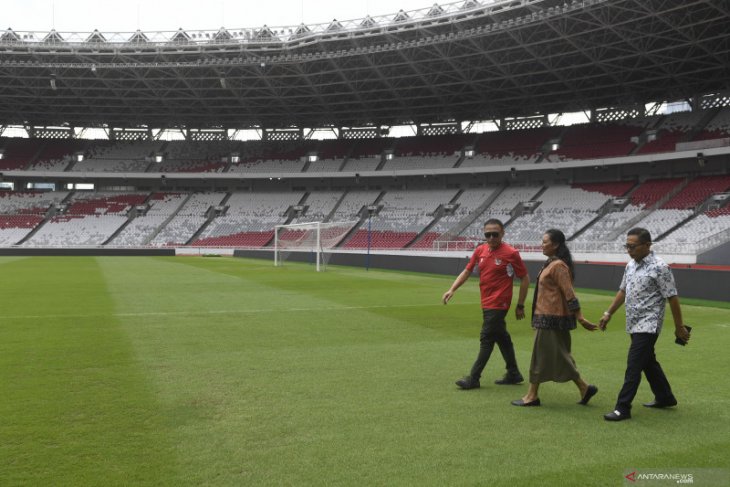Live Streaming
Program Highlight
Company Profile
May
AP II Airports Enforce New Rules for Passenger Departures
Written by Ani Hasanah
Illustration: An officer scans a passenger’s body temperature at Terminal 1 of the Soekarno Hatta Airport. (ANTARA FOTO/MUHAMMAD IQBAL)
Airports under the management of PT Angkasa Pura II have implemented new procedures for departures, under which, passengers would have to report at the airports three to four hours before their flights depart.
The new procedures are being enforced at all airports managed by PT Angkasa Pura II, in accordance with the situations and conditions on the field, director of operations and services of PT Angkasa Pura II, Muhamad Wasid, said in a statement received in Jakarta on Saturday.
"The new procedures for the departure process are being implemented to ensure that the requirements stipulated in letter number 4 of 2020 from the Task Force for Acceleration of COVID-19 Handling, as well as letter number 31 of 2020 from the Directorate General of Air Transportation from the Ministry of Transportation, are met," he stated.
He said the new procedures are being strictly followed to the last detail. Passengers are being requested to be present at the airport three to four hours before the scheduled departure.
"The new procedures could be implemented as the result of intensive coordination among all airport stakeholders, such as the Port Health Office, the military and police forces, airport authorities, airlines, and other parties," Muhamad Wasid noted.
At the Soekarno-Hatta International Airport, new procedures have also been implemented for passengers taking domestic flights during the Eid holiday period, when people have been barred from traveling to their hometowns.
The government has permitted rescheduled domestic commercial flights, starting May 7, 2020, to address COVID-19 in Indonesia.
Passengers will be allowed to travel after they meet a number of conditions, as stated in Circular Letter (SE) Number 4 of 2020 concerning Criteria for Limiting Travel for Persons in Order to Accelerate Handling of COVID-19, issued by the task force.
PT Angkasa Pura II airports are implementing the new procedures for passenger departures in line with the decision on the opening of flights. (ANTARA)
Launching the EU-ASEAN Blue Book 2020, the European Union Invites ASEAN to Enhance Cooperation Against Pandemics
Written by Ani HasanahJakarta (VOI News) - The European Union (EU) Ambassador to ASEAN Igor Driesmans launched the EU-ASEAN Blue Book 2020 Cooperation Report, Friday (05/08/2020) in Jakarta. The Blue Book is an annual publication on cooperation between the European Union and ASEAN. This year, the Blue Book with the theme "Natural Partners" that reflects the cooperation of the European Union and ASEAN covers issues of trade and economic integration, connectivity, policy dialogue, and mitigation of climate change and the environment.
In his remarks, Igor Driesmans highlighted the global conditions affected by the Coronavirus pandemic. According to him in the future, the cooperation program between the European Union and ASEAN will be more focused on efforts to respond to the pandemic. Previously, the European Union had channeled aid amounting to 350 million Euros to support efforts against the pandemic by ASEAN.
Igor stated that as a partner, the European Union supported ASEAN to make a collective effort as a region to deal with the Coronavirus pandemic.
"Of course today we all have in our minds the Corona Virus and we have decided to work together with ASEAN hand in hand. On the 20th of March, our foreign ministers with health ministers and other officials met to discuss what to do together to combat the Corona Virus. For us, this is an international fight. International solidarity. International cooperation is the key to combat the Corona Virus. And it wasn't about looking inwards. It’s about reaching out hands and because at the end of the day no one will be safe and that’s everybody to save, said Ambassador Igor Driesmans.
Regarding the cooperation between the European Union and ASEAN, Ambassador Igor Driesmans expressed that the cooperation between the two regions has progressed better. The two sides have collaborated on a variety of issues ranging from climate change to maritime security, the digital economy to high-power computerization.
According to him, until now, the European Union is still the number one development partner for ASEAN with a portfolio of 250 billion Euros. European Union investment in ASEAN is recorded as the highest investment and the second-largest trading partner for ASEAN. This collaboration is expected to continue to be improved in the future. (VOI/ANDY/AHM)
May
GBK Tops Ranking for Most Favorite Stadium in Southeast Asia
Written by Ani HasanahGelora Bung Karno Stadium. ANTARA PHOTO
The Gelora Bung Karno (GBK) Stadium in Senayan, Central Jakarta, was named the most favorite stadium in Southeast Asia after securing the highest number of votes, according to the Asian Football Confederation (AFC).
GBK clinched the top ranking after pocketing 58 percent of the total votes, surpassing the Australia Stadium in Sydney; My Dinh Stadium in Hanoi, Vietnam; and Rajamangala Stadium in Bangkok, Thailand, according to the AFC official website monitored on Friday.
Construction of the GBK Stadium was completed in 1962, in the nick of time for Indonesia to host the Fourth Asian Games.
In due course of time, the stadium was renovated multiple times. The last renovation was completed in 2018 when the country hosted the multi-sport event for the second time
Currently, the GBK Stadium has met FIFA’s minimum safety and security standards. In the event of an emergency, the stadium, with a seating capacity of 80 thousand, can be emptied in 15 minutes.
The GBK Stadium has become a venue to hold a series of football tournaments, including the Asia Cup 2007; Asian Games and Asian Para Games 2018; AFC Cups 2002, 2004, and 2008; and U-19 Asia Cup 2018.
In addition to sports events, the GBK Stadium can be used to hold music concerts, religious gatherings, and large-scale public activities.
The lighting system installed at the stadium has a brightness level of 3,500 lux, three times higher than before. It can save 50 percent of the total power requirements since it uses LED rather than conventional light. (ANTARA)
May
Pupuk Indonesia Fertilizer Production Hit Record High in 2019
Written by Ani HasanahState-owned fertilizer producer PT Pupuk Indonesia (Persero) has recorded the highest fertilizer production in history, at 11,838,451 tons, in 2019, or 101.84 
PT Pupuk Indonesia has recorded the highest fertilizer production in history at 11.8 million tons in 2019. ANTARA/HO-Pupuk Indonesia
State-owned fertilizer producer PT Pupuk Indonesia (Persero) has recorded the highest fertilizer production in history, at 11,838,451 tons, in 2019, or 101.84 percent of its targeted 11,625,000 tons.
President Director of PT Pupuk Indonesia Aas Asikin Idat revealed that the company has shown encouraging performance in 2019, with positive growth in production consolidation, sales, revenue, and profit exceeding the target set by stakeholders.
"Performance in production in 2019 is relatively good as compared to 2018. This was reflected in the production volume that increased by 448,226 tons, or 2.43 percent, as compared to the production in 2018," Idat stated in Jakarta on Friday.
Among the factors that have boosted production is the new factory in Gresik that commences its production in August 2018.
In addition to fertilizers, the company has produced 5.9 million tons of ammonia, or 101.29 percent of its targeted 5.8 million tons; sulfate acid, 849,510 tons, or 99.4 percent of the target; and phosphoric acid, 270,333 tons, or 108.13 percent of the target.
Idat remarked that fertilizer producers -- PT Pupuk Kaltim, PT Petrokimia Gresik, PT Pupuk Sriwidjaja Palembang, PT Pupuk Kujang, and PT Pupuk Iskandar Muda Aceh -- as members of the holding company -- have maintained the capability of factories.
"This was reflected in the increased efficiency of gas consumption as raw material," he noted.
In 2019, the company had distributed 8.7 million tons of subsidized fertilizer, or 91.19 percent of the target. The government has adjusted the company's obligation to distribute 8.8 million tons of subsidized fertilizer in the year, as compared to 9.5 million tons obligated in 2018.
"We applaud subsidiary companies, especially fertilizer producers, for facilitating fertilizer supply at a subsidized rate. Thus, we could meet the requirement," he added. (ANTARA)




